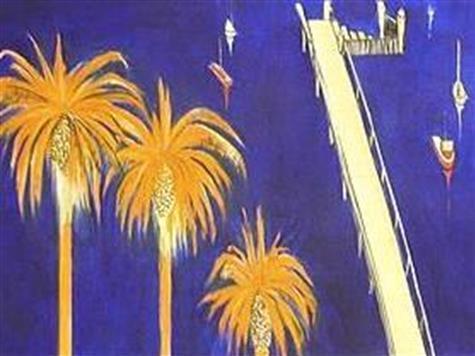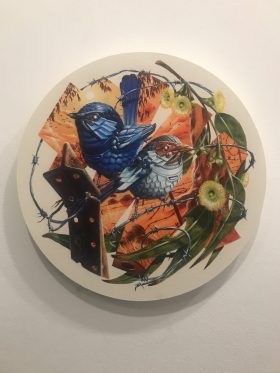Detail of alleged Whiteley Blue Lavender Bay, sold for $2.5 million to Sydney Swans chairman Andrew Pridham in 2007. Photo: Supplied
What has been labeled Australia’s biggest art fraud case has had a sensational ending.
Yesterday, the Victorian Court of Appeal overturned the jury’s finding that a Melbourne conservator and art dealer were guilty of fraud.
Peter Stanley Gant and Mohame Aman Siddique were convicted in May last year of two counts each of obtaining a financial advantage by deception. Gant was sentenced to five years in jail, and Siddique two-and-a-half.
The paintings had been allegedly made by conservator Siddique and sold by art dealer Grant. The pair have consistently pleaded their innocence.
The Crown prosecutor Daniel Gurvich QC told the Victorian Court of Appeal: ‘There is here a significant possibility that innocent men have been convicted, and each of them should accordingly be acquitted.’
Justices Mark Weinberg, Phillip Priest and Stephen McLeish agreed to quash the convictions, saying it was an unprecedented case in which the jury had simply got it wrong.
‘This case is a rare and almost unique instance of the system having failed,’ said Weinberg.
Justice Weinberg said the Court of Appeal was not bound by the Crown’s concession.
The late artist’s wife, Wendy Whiteley, who testified in the case before the Supreme Court of Victoria last year that she believed three paintings attributed to her husband were fakes, told Fairfax that she was ‘stunned and I’m in shock, I can’t believe it’, at yesterday’s decision.
Appeal Judge Weinberg said he, Justice Phillip Priest, and Justice Stephen McLeish would not comment on the prosecution case against Gant and Siddique.
‘We do not propose at this time to express any criticism about the decision to pursue these charges,’ he said.
Weinberg’s written decision read: ‘It is sometimes said that juries “always get it right”. Sadly in this particular instance, that seems not to have been so.
‘This case is a rare and almost unique instance of the system having failed in that regard. It is fortunate that the mechanism of the appeal to this court, coupled with the fairness of the prosecuting authorities in recognising that failure, has resulted in the rectification of that error,’ he said.

Evidence outside Victorian Court of Appeal; Photo ABC News: Stephanie Ferrier
The case
Three counts went before the Melbourne Magistrates Court on 27 August 2014; one for the financial gain of $2.5 million for producing and fraudulently selling the painting Lavender Bay (detail pictured top) as a genuine work by Whiteley; the second for a like painting, Orange Lavender Bay for $1.1 million, and a third charge for the painting Through the Window Lavender Bay, which Grant attempted to sell for $950,000.
Read: Alleged Whiteley forger finally charged
Wendy Whiteley told the original trial the paintings lacked the artist’s ‘verve’ and couldn’t be his work.
Two key witnesses gave testimonies at the trial, adding weight to the prosecutor’s argument.
Jeremy James told the original trial he had photographed both Big Blue and Orange Lavender Bay for a 1989 Gant catalogue; and Rosemary Milburn, Gant’s former gallery assistant, told the Court she was present during the delivery of the three paintings, and had a hand-written and signed note recording their arrivals at Gant’s gallery in 1988.
The Age reported that when the original trial heard this evidence, Justice Michael Croucher ruled it had so seriously damaged the Crown’s case the jury could have leave to immediately acquit the men.
The jury decided against Croucher’s view, finding the pair guilty.
The Court of Appeal judges said they had all independently arrived at the view ‘that these convictions could not stand.’





